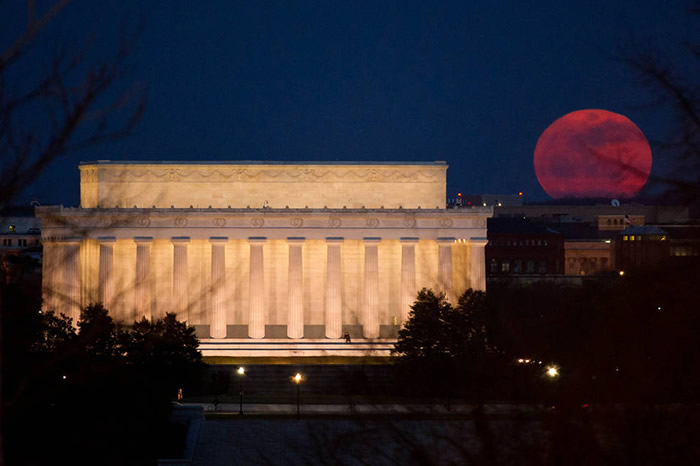If you can’t lasso it, then here’s how to snap the supermoon
Weather permitting, on Sunday, November 13th and Monday, November 14th, you’ll be treated to a showstopper supermoon that will be the closest moon to Earth in almost 70 years. We won’t see a supermoon like this until 2034, so this is a great opportunity to preserve and share the event with a great photo.
Enter Bill Ingalls, NASA’s senior photographer and a fixture at NASA Headquarters, with a salt-and-pepper ponytail and a ready smile. Bill has traveled all over the world for more than 25 years photographing missions for NASA, but he can also be found right in his own backyard – the DC area – anytime there’s a supermoon, meteor shower or other eye candy in the heavens.
Bill’s #1 tip for capturing that great lunar photo: “Don’t make the mistake of photographing the moon by itself with no reference to anything,” he said. “I’ve certainly done it myself, but everyone will get that shot. Instead, think of how to make the image creative—that means tying it into some land-based object. It can be a local landmark or anything to give your photo a sense of place.”
Ingalls goes to great lengths to scout out the perfect vantage point to juxtapose the moon with various Washington monuments. “It means doing a lot of homework. I use Google Maps and other apps – even a compass — to plan where to get just the right angle at the right time.” He often scouts locations a day or more in advance, getting permission to access rooftops or traveling to remote areas to avoid light pollution.
A slight miscalculation can result in a mad scramble; he recalls seeing hundreds of photographers who set tripods hundreds of yards away for a supermoon shot from Washington’s Iwo Jima monument. “I thought my calculations were wrong, but – sure enough – the moon popped up right where I expected, and then came the stampede,” he chuckled.
You don’t have to live near an iconic landmark or talk your way onto a rooftop to get the perfect shot. Instead, work with what you have. Ingalls trekked to Shenandoah National Park in 2009 to photograph Comet Lulin and faced a challenge. “I had just basic equipment and saw all these people with great telescopes making a picture I could never get. So what could I do differently?” Ingalls aimed his long lens between the trees, using the red light of his headlamp to paint the forest with a long exposure. The result was magical, with National Geographic naming his comet image one of the top 10 space photos of the year.
Ingalls says the November 14th supermoon can be a great family activity, whether you head outside after sunset or early in the morning. “I think this would be a lot of fun to do with kids, if nothing else, to just have them witness it and talk about what’s taking place.” He recommends personalizing the experience by using people in the shot. “There are lots of great photos of people appearing to be holding the moon in their hand and that kind of thing. You can get really creative with it,” he said.
While the moon will be at perigee – the closest point to Earth – at 6:22 a.m. EST on Monday the 14th, viewing will still be super after sunset on both November 13th and November 14th, with only subtle difference in the moon’s size and brightness. So this will provide lots of opportunity to experiment with different locations, exposure times and foregrounds. And if it’s cloudy on Sunday night, you can always try again on Monday.
Is it hopeless to attempt a supermoon image with a smartphone camera? Ingalls says, “It’s all relative. For me, it would be maddening and frustrating–yet it may be a good challenge, actually. You’re not going to get a giant moon in your shot, but you can do something more panoramic, including some foreground that’s interesting. Think about being in an urban area where it’s a little bit brighter.”
To get the right light balance of the moon on newer iPhones and other smartphones, “Tap the screen and hold your finger on the object (in this case, the moon) to lock the focus. Then slide your finger up or down to darken or lighten the exposure.”
For digital SLR photography, Ingalls uses the daylight white balance setting for capturing moonlight, since sunlight is being reflected. For those with longer lenses he advises, “Keep in mind that the moon is a moving object. It’s a balancing act between trying to get the right exposure and realizing that the shutter speed typically needs to be a lot faster.”
While Ingalls will be on assignment in Baikonur, Kazakhstan during next week’s celestial event, the supermoon is still beckoning. “I certainly hope I can get something,” he said.
More information: NASA



Comments are closed, but trackbacks and pingbacks are open.